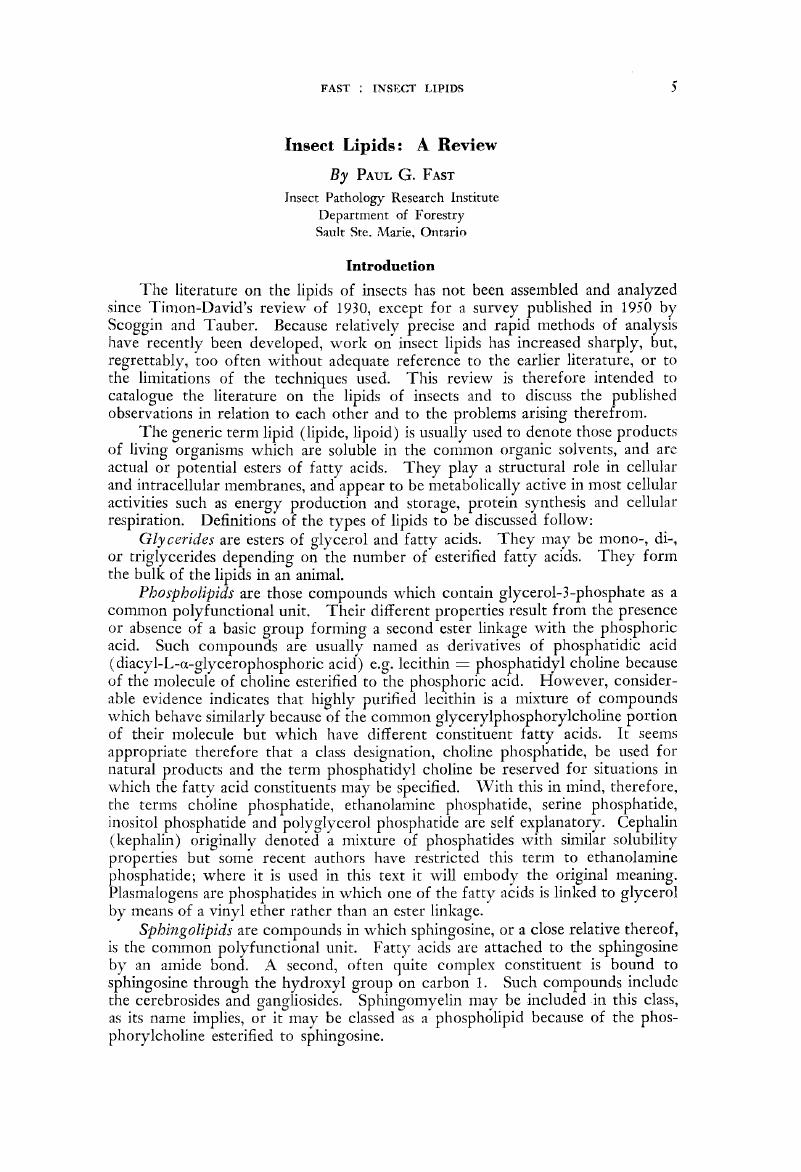Crossref Citations
This article has been cited by the following publications. This list is generated based on data provided by Crossref.
Gilbert, Lawrence I.
Chino, Haruo
and
Domroese, Kenneth A.
1965.
Lipolytic activity of insect tissues and its significance in lipid transport.
Journal of Insect Physiology,
Vol. 11,
Issue. 8,
p.
1057.
Allen, R.R.
and
Newburgh, R.W.
1965.
Phospholipid composition of fat-bodies of Sarcophaga bullata.
Journal of Insect Physiology,
Vol. 11,
Issue. 12,
p.
1601.
EL‐HARIRI, G.
1966.
CHANGES IN METABOLIC RESERVES OF THREE SPECIES OF APHIDOPHAGOUS COCCINELLIDAE (COLEOPTERA) DURING METAMORPHOSIS.
Entomologia Experimentalis et Applicata,
Vol. 9,
Issue. 3,
p.
349.
Kinsella, John E.
1966.
Obervations on the changing lipid patterns during the life cycle of Oncopeltus fasciatus.
Comparative Biochemistry and Physiology,
Vol. 17,
Issue. 4,
p.
1209.
Hora, J.
Lábler, L.
Kasal, A.
Černý, V.
Šorm, F.
and
Sláma, K.
1966.
On steroids CIII. Molting deficiencies produced by some sterol derivatives in an insect (Pyrrhocoris apterus L.).
Steroids,
Vol. 8,
Issue. 6,
p.
887.
Bumgarner, Joseph E.
and
Lambremont, Edward N.
1966.
The lipid-class spectrum and fatty-acid content of the boll weevil egg.
Comparative Biochemistry and Physiology,
Vol. 18,
Issue. 4,
p.
975.
Harvey, W.R.
and
Haskell, J.A.
1966.
Advances in Insect Physiology Volume 3.
Vol. 3,
Issue. ,
p.
133.
Nelson, D.R
Terranova, A.C
and
Sukkestad, D.R
1967.
Fatty acid composition of the glycerine and free fatty acid fractions of the fat body, and hemolymph of the cockroach, Periplaneta americana (L.).
Comparative Biochemistry and Physiology,
Vol. 20,
Issue. 3,
p.
907.
Nakasone, Shoichi
and
Ito, Toshio
1967.
Fatty acid composition of the silkworm, Bombyx mori L..
Journal of Insect Physiology,
Vol. 13,
Issue. 8,
p.
1237.
Ito, Toshio
and
Nakasone, Shoichi
1967.
Nutrition of the silkworm, Bombyx mori—XV. Utilization of sterol in the presence of dietary fatty acids.
Journal of Insect Physiology,
Vol. 13,
Issue. 2,
p.
281.
Wimer, L.T.
and
Lumb, R.H.
1967.
Lipid composition of the developing larval fat body of Phormia regina.
Journal of Insect Physiology,
Vol. 13,
Issue. 6,
p.
889.
Earle, N.W.
Slatten, Billie
and
Burks, M.L.
1967.
Essential fatty acids in the diet of the boll weevil, Anthonomus grandis Boheman (Coleoptera: Curculionidae).
Journal of Insect Physiology,
Vol. 13,
Issue. 2,
p.
187.
Gilbert, Lawrence I.
1967.
Advances in Insect Physiology Volume 4.
Vol. 4,
Issue. ,
p.
69.
Schaefer, C.H.
1968.
The relationship of the fatty acid composition of Heliothis zea larvae to that of its diet.
Journal of Insect Physiology,
Vol. 14,
Issue. 2,
p.
171.
Walling, M.V.
White, David C.
and
Rodriguez, J.G.
1968.
Characterization, distribution, catabolism, and synthesis of the fatty acids of the two-spotted spider mite, Tetranychus urticae.
Journal of Insect Physiology,
Vol. 14,
Issue. 10,
p.
1445.
Sun, Grace Y.
and
Brookes, Victor J.
1968.
The deposition of lipid and the composition of neutral lipids in the fat body of Sarcophaga bullata (diptera).
Comparative Biochemistry and Physiology,
Vol. 24,
Issue. 1,
p.
177.
Nelson, D.R.
and
Sukkestad, D.R.
1968.
Fatty acid composition of the diet and larvae and biosynthesis of fatty acids from 14C-acetate in the cabbage looper, Trichoplusia ni.
Journal of Insect Physiology,
Vol. 14,
Issue. 2,
p.
293.
McFarlane, J.E.
1968.
Fatty acids, methyl esters and insect growth.
Comparative Biochemistry and Physiology,
Vol. 24,
Issue. 2,
p.
377.
Lambremont, Edward N
and
Graves, Jerry B
1969.
Incorporation of acetate-1-14C into neutral lipids and phospholipids during late developmental stages of Heliothis zea.
Comparative Biochemistry and Physiology,
Vol. 30,
Issue. 2,
p.
347.
MORIARTY, F.
1969.
THE SUBLETHAL EFFECTS OF SYNTHETIC INSECTICIDES ON INSECTS.
Biological Reviews,
Vol. 44,
Issue. 3,
p.
321.





